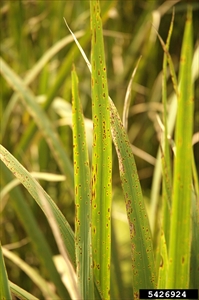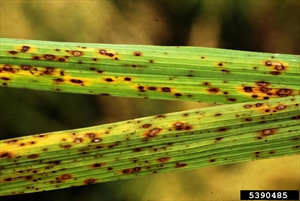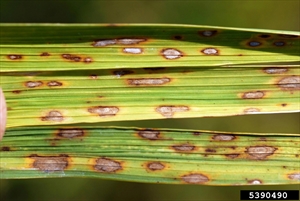Rice brown leaf spot. It is also known as glume blotch.
Pacific Pests, Pathogens, Weeds & Pesticides - Online edition
Pacific Pests, Pathogens, Weeds & Pesticides
Rice brown leaf spot (427)
Cochiobolus miyabeanus. It is also known by its asexual name, Bipolaris oryzae.
Asia, Africa, North, South and Central America, the Caribbean, Europe, Oceania. It is recorded from Australia, Fiji, French Polynesia, New Caledonia, Papua New Guinea, and Solomon Islands.
Rice and wild grasses.
A fungus causes rice brown leaf spot disease. It is a common disease of seedlings, and on leaves, leaf sheaths, panicles, including the glumes and seeds, of developing and mature plants. The disease is worse in dryland compared to wetland cultivation, especially under continuous cropping and other situations where fertility is low. Low levels of NPK, and perhaps silica and manganese, are said to be associated with the disease.
Seedlings show small, circular, yellow-brown or brown spots girdling and distorting the leaf sheaths. Later, at tillering, circular to oval spots, up to 10 mm long, dark brown to purple, appear on the leaves (Photos 1&2). When mature, they have light brown to grey centres, surrounded by dark brown margins (Photos 2&3). On the seeds, the 'eye-spot' symptom (brown with light centres) is more pronounced (Photo 4). Infected seeds do not fill properly. Black spore masses develop on the spots of both leaves and seeds.
The disease is most severe when humidity is high, over 85%, for a few days with light rains, heavy dews, and temperature between 20-30°C.
Spread occurs over short distances as spores in the wind. Infected seed allows spread over longer distances. Survival occurs in infected seed, on volunteer rice, rice debris, and wild grasses.
It is not considered a serious disease, especially when compared to rice blast (see Fact Sheet no. 252). However, IRRI calculates that losses of 5% yield from this fungus occur throughout South and Southeast Asia annually, with local losses exceeding 40%. The losses are caused by a combination of seedling death and loss in quality and weight from seed infections. There appears to be a correlation between impact and soil nutrient deficiency.
The spots are similar to rice blast (see Fact Sheet no. 242), but differ: (i) they usually appear later, and (ii) the spots are more regular in outline and have lighter centres. Look for the large brown lesions, up to 2.5 cm long, on the stems under the leaf sheaths, when stripped away.
CULTURAL CONTROL
Before planting:
- Treat seed with hot water: 53-54°C for 10-12 minutes.
During growth:
- Ensure that plants have correct nutrition: apply fertilizer at recommended rates.
After harvest:
- Collect straw and other debris after harvest and burn it with the stubble, or plough everything into the soil.
RESISTANT VARIEITES
Use resistant varieties. Check with local agriculture extension staff for those that are appropriate in your region.
CHEMICAL CONTROL
Chemical control should only be considered after investigating the possibility of nutritional deficiencies and the availability of resistant varieties. IRRI recommends seed treatments with iprodione, strobilburins (azoxystrobin or trifloxystrobin), azole (propiconazole), or carbendazin fungicides. Foliar treatments at tillering and at late boot stage (extension of flag leaf) have also been recommended but are effective only if combined with a seed treatment.
____________________
When using a pesticide, always wear protective clothing and follow the instructions on the product label, such as dosage, timing of application, and pre-harvest interval. Recommendations will vary with the crop and system of cultivation. Expert advice on the most appropriate pesticide to use should always be sought from local agricultural authorities.
AUTHOR Grahame Jackson
Information from Sparks A (undated) Brown spot. Rice Knowledge Bank. IRRI. (http://www.knowledgebank.irri.org/training/fact-sheets/pest-management/diseases/item/brown-spot); and Cochliobolus miyabeanus. Wikipedia (https://en.wikipedia.org/wiki/Cochliobolus_miyabeanus); and CABI (2018) Cochliobolus miyabeanus (brown leaf spot of rice). Crop Protection Compendium. (https://www.cabi.org/cpc/datasheet/14691); and from Graham KM (1971) Plant diseases of Fiji. Her Majesty's Stationery Office. London. Photo 1 Yuan-Min Shen, Taichung District Agricultural Research and Extension Station, Bugwood.org. Photos 2-4 Donald Groth, Louisiana State University AgCenter, Bugwood.org
Produced with support from the Australian Centre for International Agricultural Research under project HORT/2016/185: Responding to emerging pest and disease threats to horticulture in the Pacific islands, implemented by the University of Queensland and the Secretariat of the Pacific Community.







